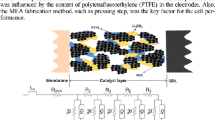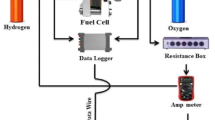Abstract
A low-humidification membrane electrode assembly (MEA) for polymer electrolyte membrane fuel cells (PEMFCs) is prepared by adding the hydrophilic polymer: polyvinyl alcohol (PVA) to the anode catalyst layer. Glutaraldehyde (GA) is employed as a crosslinking agent for PVA to prevent washing from the anode during cell operation. This is confirmed by an immersion test in deionized water for 2 h. A single cell test is conducted at 80 °C, ambient pressure, and 50 % relative humidity. Although MEA containing 1 wt% non-crosslinked PVA shows the best initial performance (788 mA cm−2 at 0.6 V), a considerable performance decrease of 41 % is observed following a 100-h durability test. However, MEA containing 5 wt% crosslinked PVA demonstrates enhanced durability, with little performance decline after 100 h of constant current operation. This strongly suggests that crosslinked PVA plays a crucial role in a low-humidification MEA at low humidity levels.








Similar content being viewed by others
References
O'Hayre R, Cha SW (2009) Fuel cell fundamentals. John Wiley & Sons Inc., Hoboken
Gottesfeld S (2009) Fuel Cell Catalysis: A Surface Science Approach. Wiley, Hoboken
Jiao K, Li X (2011) Prog Energy Combust Sci 37:221–291
Yim SD, Sohn YJ, Park SH, Yoon YG, Park GG, Yang TH, Kim CS (2011) Fabrication of microstructure controlled cathode catalyst layers and their effect on water management in polymer electrolyte fuel cells. Electrochim Acta 56:9064–9073
Wang L, Advani SG, Prasad AK (2012) Nafion membranes modified with silica sulfuric acid for the elevated temperature and lower humidity operation of PEMFC. Electrochem Solid-State Lett 15:B44–B47
Kumar GG, Kim AR, Nahm KS, Elizabeth R (2009) Ionic Liquid-Based Composite Membrane for PEMFCs Operating under Low Relative Humidity Conditions. Int J Hydrogen Energy 34:9788–9794
Amjadi M, Rowshanzamir S, Peighambardoust SJ, Hosseini MG, Eikani MH (2010) Investigation of physical properties and cell performance of Nafion/TiO2 nanocomposite membranes for high temperature PEM fuel cells. Int J Hydrogen Energy 35:9252–9260
Endoh E, Terazono S, Widjaja H, Takimoto Y (2004) Degradation Study of MEA for PEMFCs under Low Humidity Conditions. Electrochem Solid-State Lett 7:A209–A211
Lee Y, Kim B, Kim Y (2009) Effects of self-humidification on the dynamic behavior of polymer electrolyte fuel cells. Int J Hydrogen Energy 34:1999–2007
Jian-hua T, Peng-fei G, Zhi-yuan Z, Wen-hui L, Zhong-qiang S (2008) Preparation and performance evaluation of a Nafion-TiO2 composite membrane for PEMFCs. Int J Hydrogen Energy 33:5686–5690
Velan VS, Velayutham G, Hebalkar N, Dhathathreyan KS (2011) Effect of SiO2 additives on the PEM fuel cell electrode performance. Int J Hydrogen Energy 36:14815–14822
Vengatesan S, Kim HJ, Lee SY, Cho EA, Ha HY, Oh IH, Hong SA, Lim TH (2008) High temperature operation of PEMFC: A novel approach using MEA with silica in catalyst layer. Int J Hydrogen Energy 33:171–178
Kannan AM, Cindrella L, Munukutla L (2008) Functionally graded nano-porous gas diffusion layer for proton exchange membrane fuel cells under low relative humidity conditions. Elctrochimica Acta 53:2416–2422
Cindrella L, Kannan AM, Ahmadc R, Thommes M (2009) Surface modification of gas diffusion layers by inorganic nanomaterials for performance enhancement of proton exchange membrane fuel cells at low RH conditions. Int J Hydrogen Energy 34:6377–6383
Jung UH, Park KT, Park EH, Kim SH (2006) Improvement of low humidity performance of PEMFC by addition of hydrophilic SiO2 particles to catalyst layer. J Power Sources 159:529–532
Su H, Xu L, Zhu H, Wu Y, Yang L, Liao S, Song H, Liang Z, Birss V (2010) Self-humidification of a PEM fuel cell using a novel Pt/SiO2/C anode catalyst. Int J Hydrogen Energy 35:7874–7880
Liang H, Zheng L, Liao S (2012) Self-humidifying membrane electrode assembly prepared by adding PVA as hygroscopic agent in anode catalyst layer. Int J Hydrogen Energy 37:12860–12867
Cindrella L, Kannan AM (2009) Membrane electrode assembly with doped polyaniline interlayer for proton exchange membrane fuel cells under low relative humidity conditions. J Power Sources 193:447–453
Kitahara T, Nakajima H, Mori K (2012) Hydrophilic and hydrophobic double microporous layer coated gas diffusion layer for enhancing performance of polymer electrolyte fuel cells under no-humidification at the cathode. J Power Sources 199:29–36
Liang H, Dang D, Xiong W, Song H, Liao S (2013) High-performance self-humidifying membrane electrode assembly prepared by simultaneously adding inorganic and organic hygroscopic materials to the anode catalyst layer. J Power Sources 241:367–372
Hou S, Liao S, Dang D, Zou H, Shu T, Du L (2014) Self-humidifying membrane electrode assembly prepared by adding microcrystalline cellulose in anode catalyst layer as preserve moisture. Int J Hydrogen Energy 39:12842–12848
Hou S, Liao S, Xiong Z, Zou H, Dang D, Zheng R, Shu T, Liang Z, Li X, Li Y (2015) Improvement of proton exchange membrane fuel cell performance in low-humidity conditions by adding hygroscopic agarose powder to the catalyst layer. J Power Sources 273:168–173
Mansur HS, Sadahira CM, Souza AN, Mansur AAP (2008) FTIR spectroscopy characterization of poly (vinyl alcohol) hydrogel with different hydrolysis degree and chemically crosslinked with glutaraldehyde. Mater Sci Eng:C 28:539–548
Rhim JW, Park HB, Lee CS, Jun JH, Kim DS, Lee YM (2004) Crosslinked poly (vinyl alcohol) membranes containing sulfonic acid group: proton and methanol transport through membranes. J Membr Sci 238:143–151
Acknowledgments
This work was partly supported by the framework of the Research and Development Program of the Korea Institute of Energy Research (KIER) (B5-2415) and the World Premium Material (WPM) Program of the Korea Evaluation Institute of Industrial Technology (KEIT) grant funded by the Ministry of Trade, Industry and Energy, Republic of Korea (No. 10037748).
Author information
Authors and Affiliations
Corresponding author
Rights and permissions
About this article
Cite this article
Kim, EY., Yim, SD., Bae, B. et al. Study of a highly durable low-humidification membrane electrode assembly using crosslinked polyvinyl alcohol for polymer electrolyte membrane fuel cells. J Solid State Electrochem 20, 1723–1730 (2016). https://doi.org/10.1007/s10008-016-3179-6
Received:
Revised:
Accepted:
Published:
Issue Date:
DOI: https://doi.org/10.1007/s10008-016-3179-6




